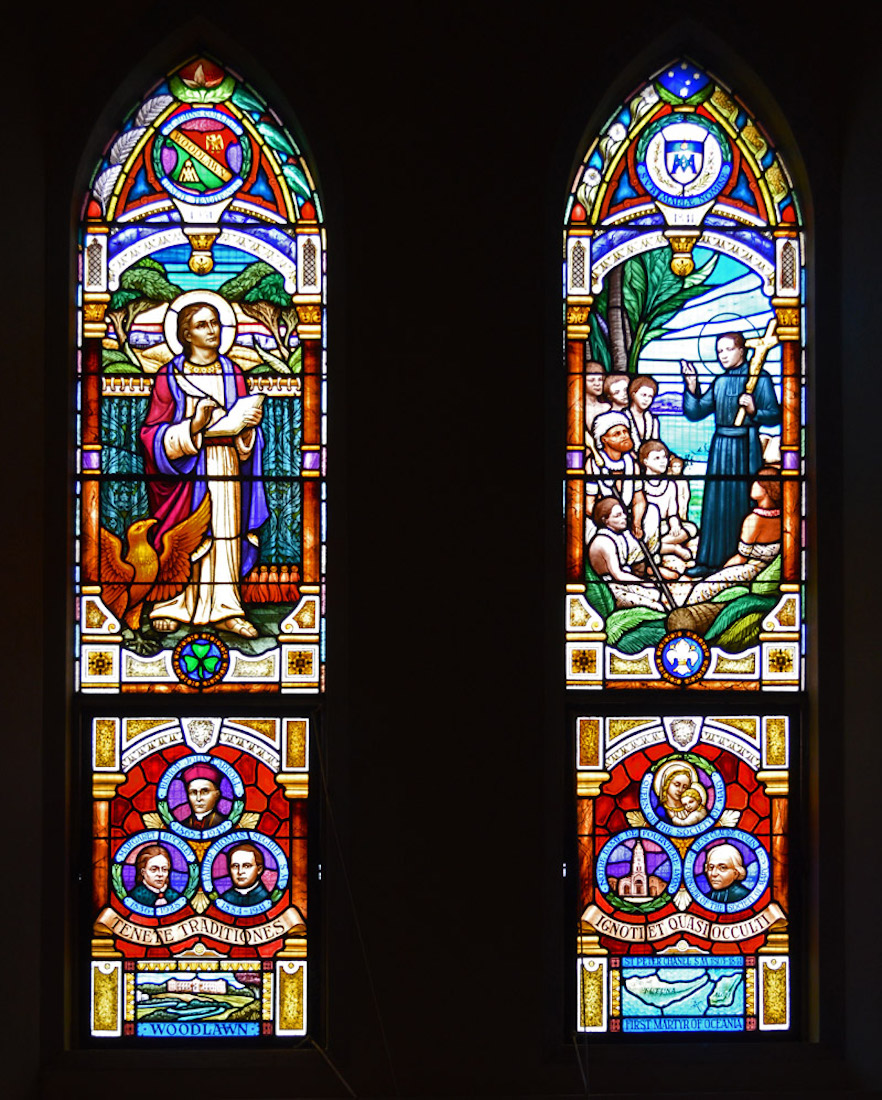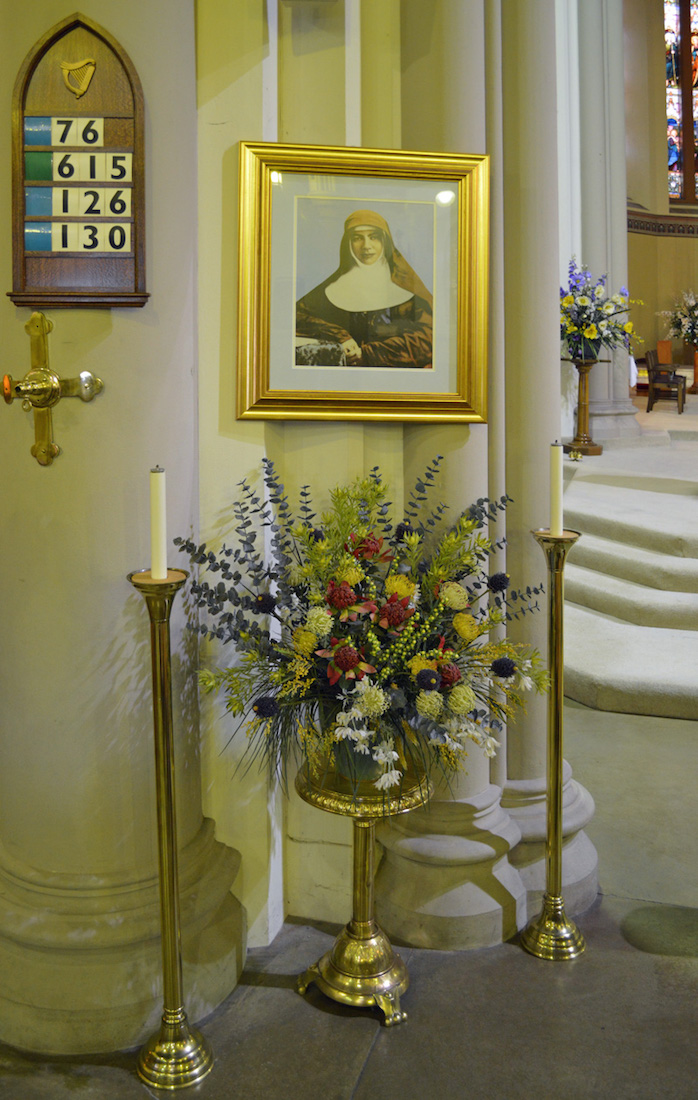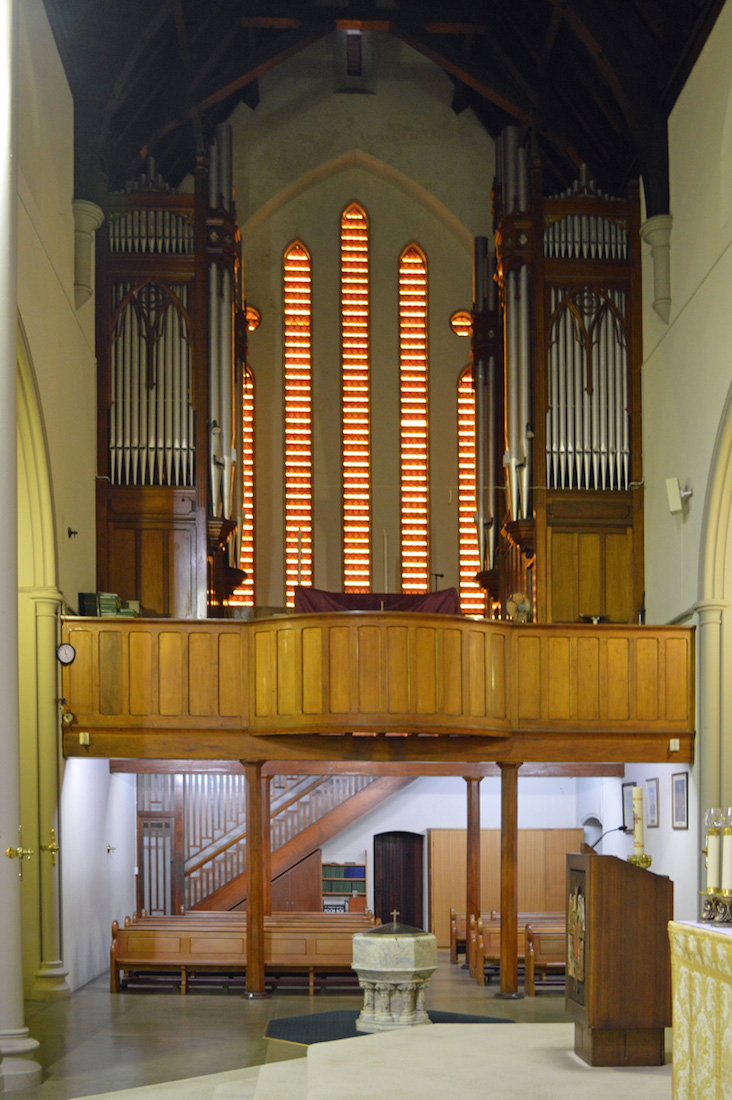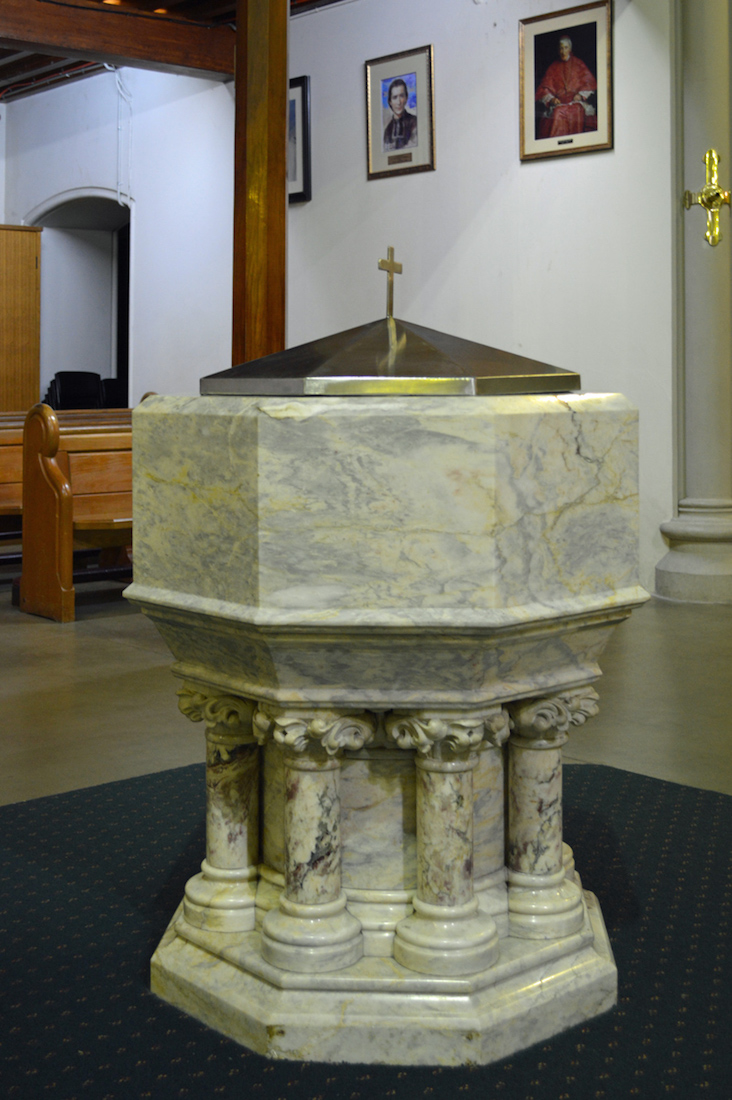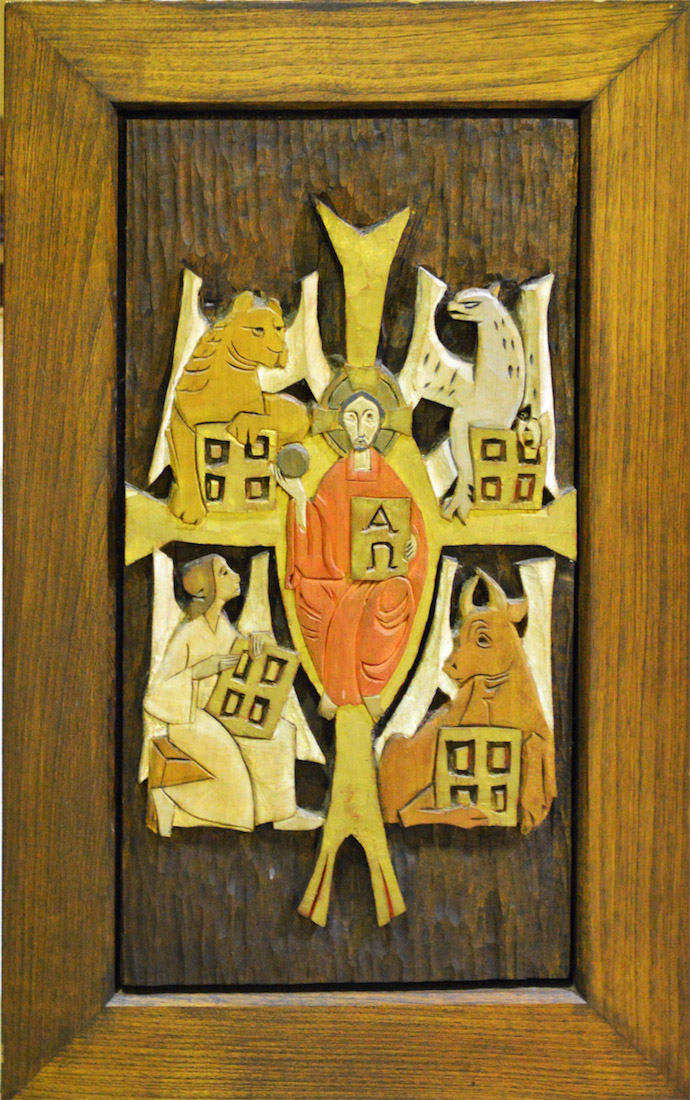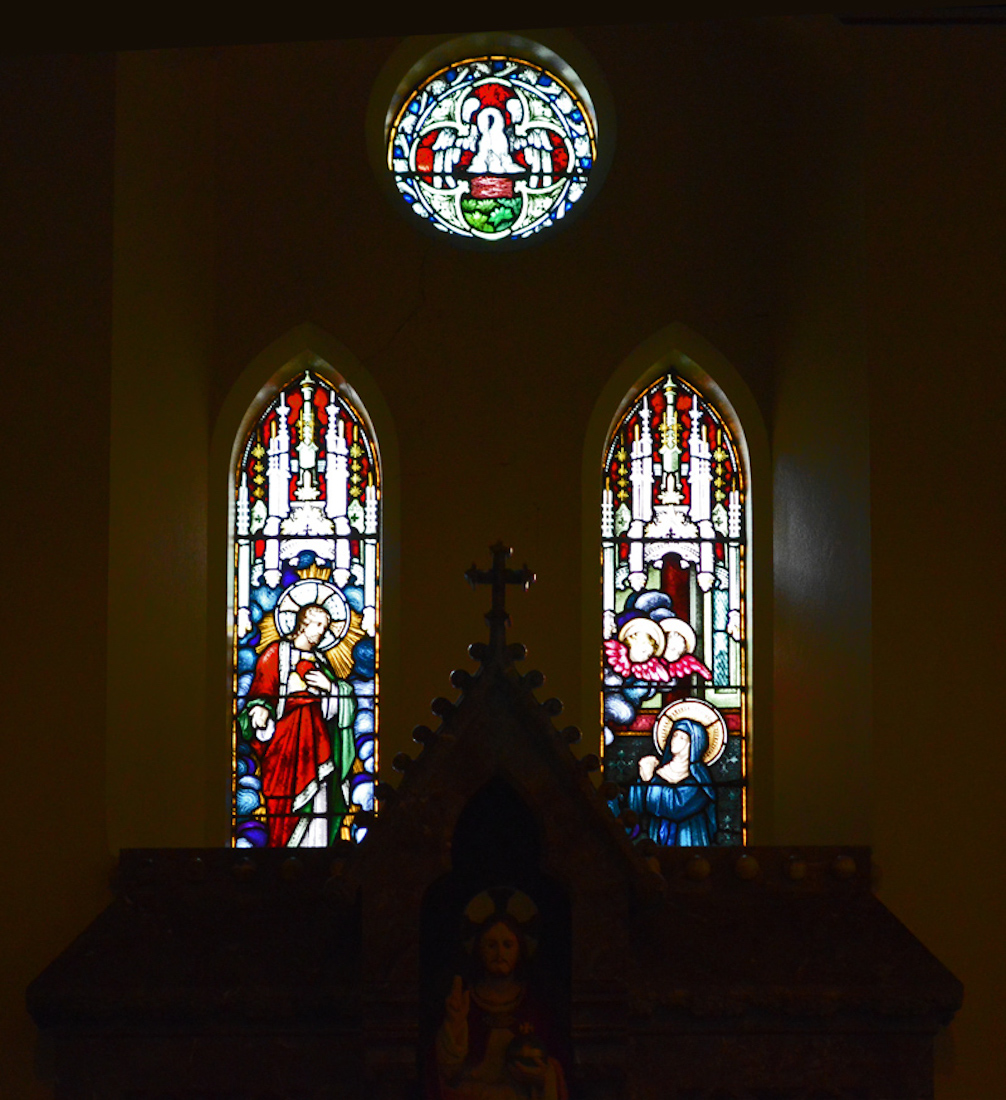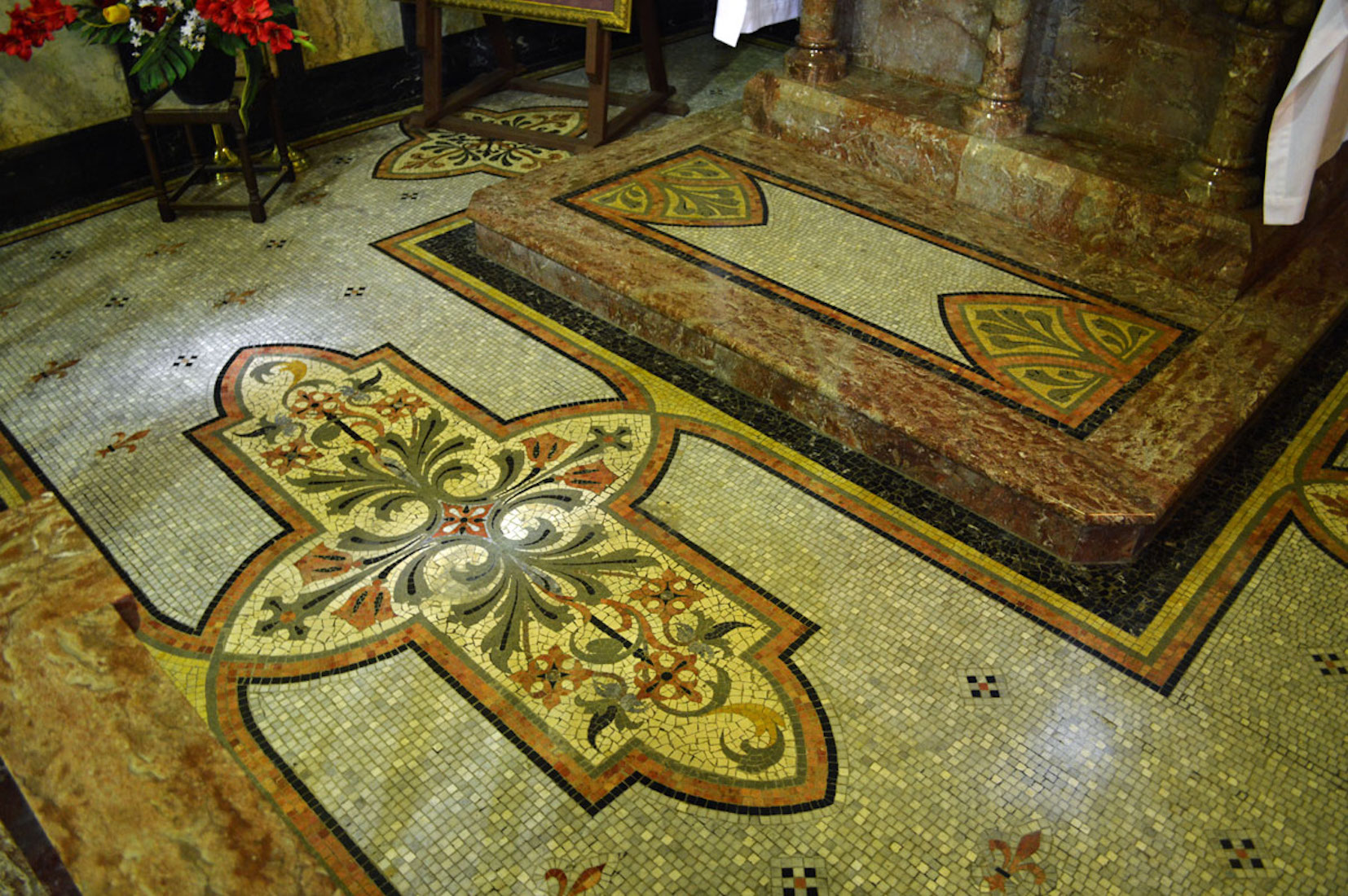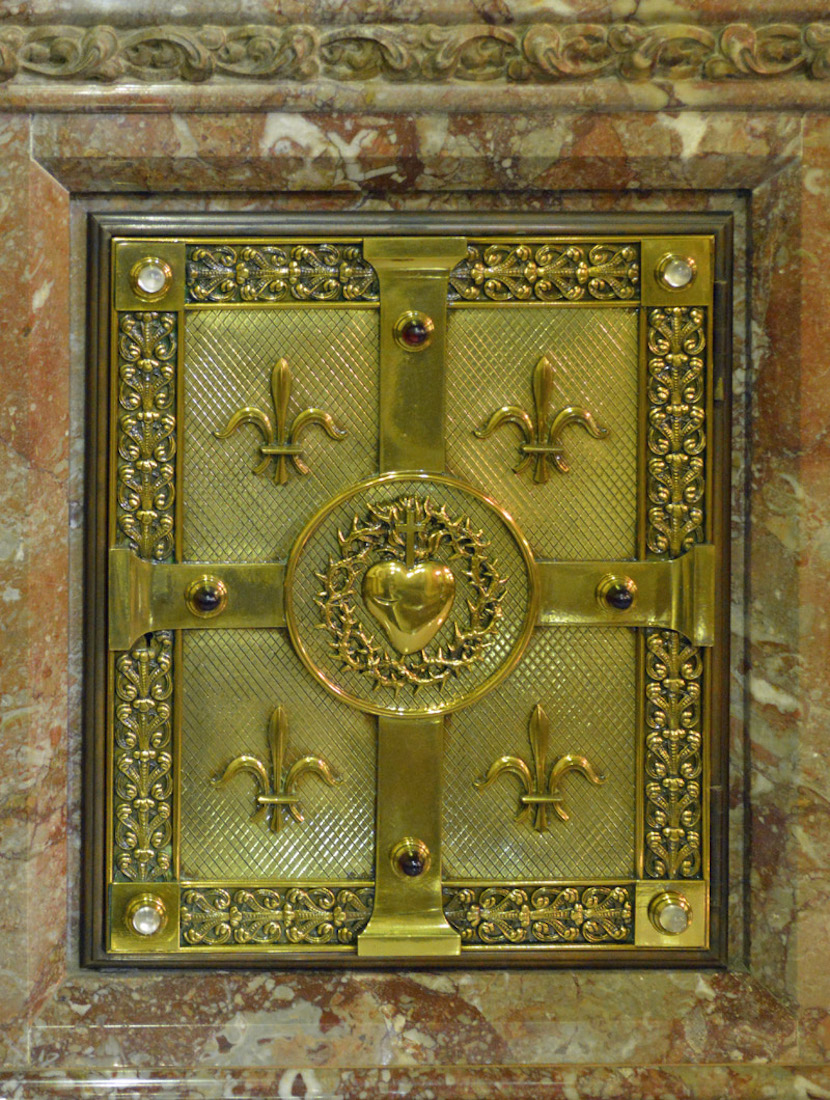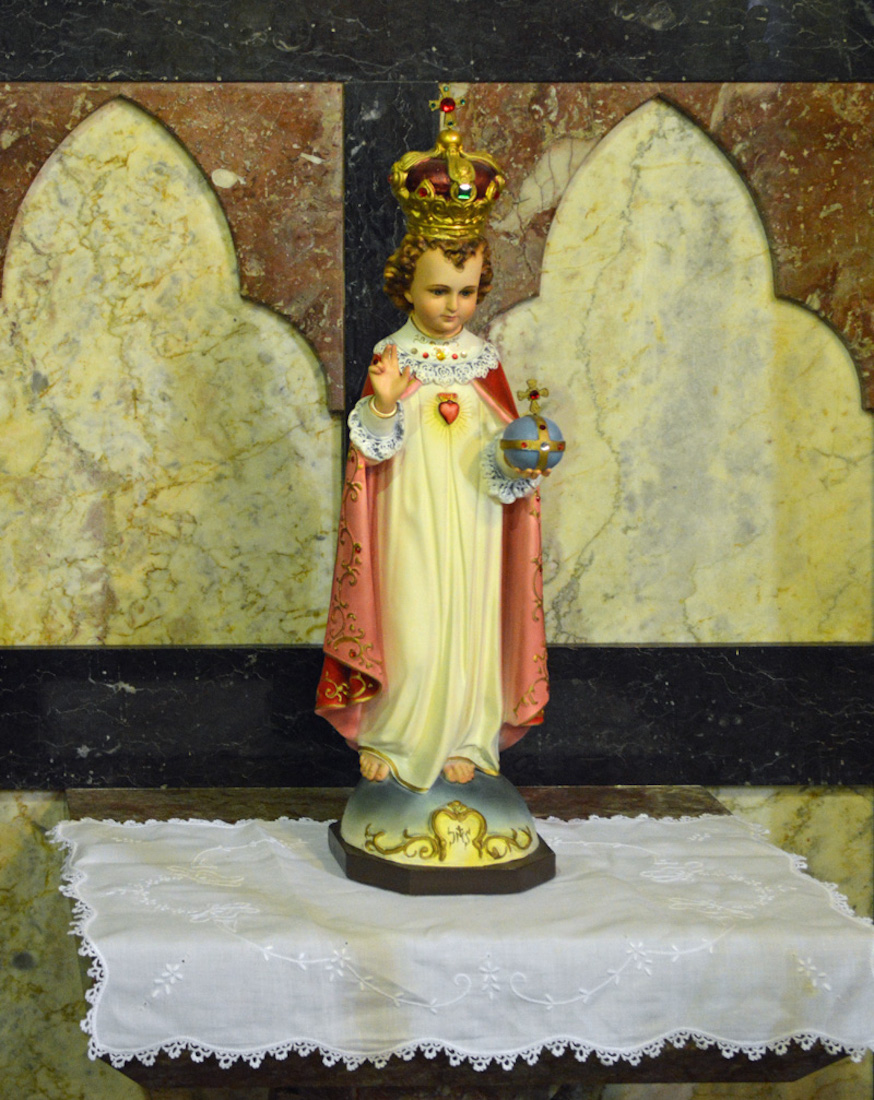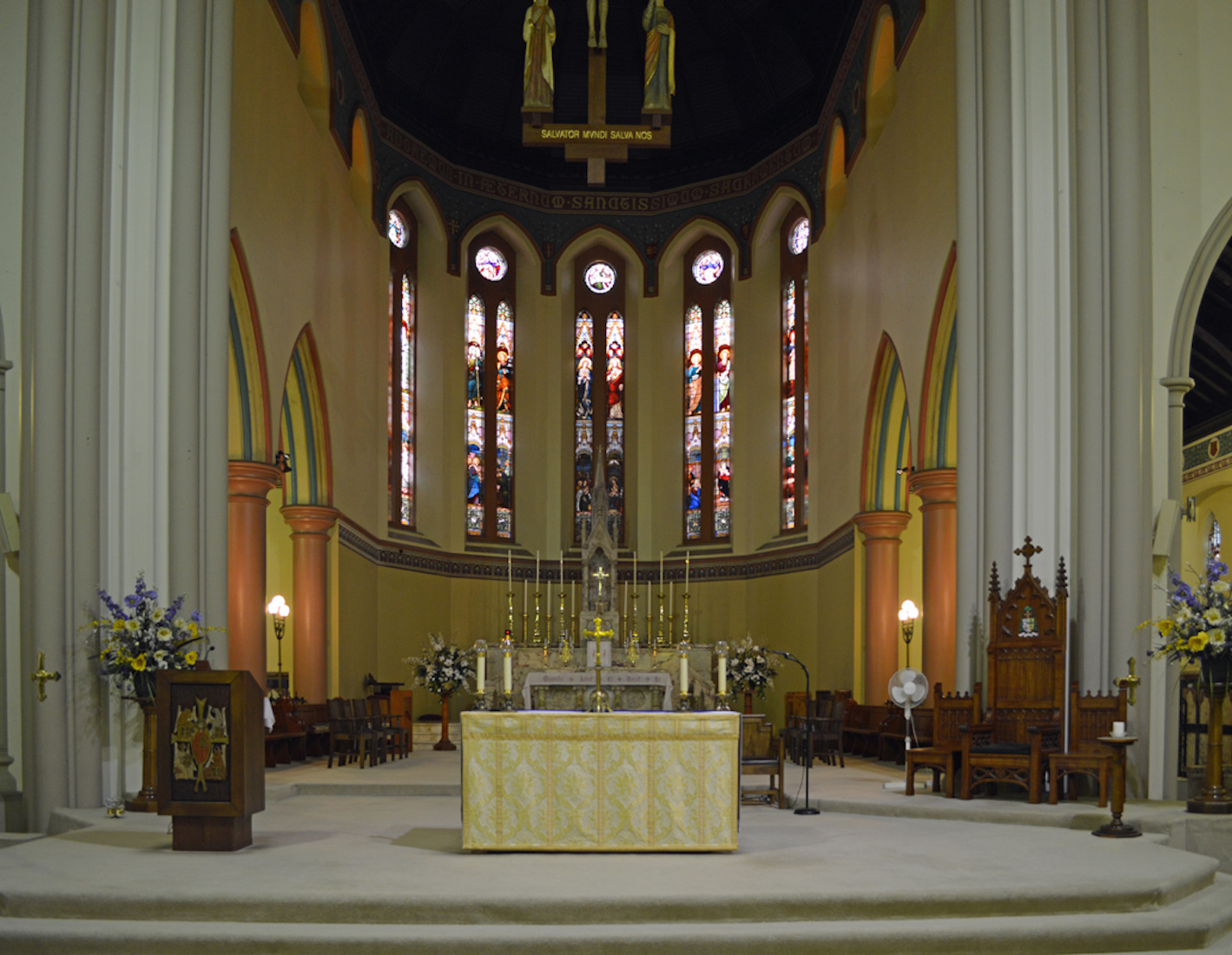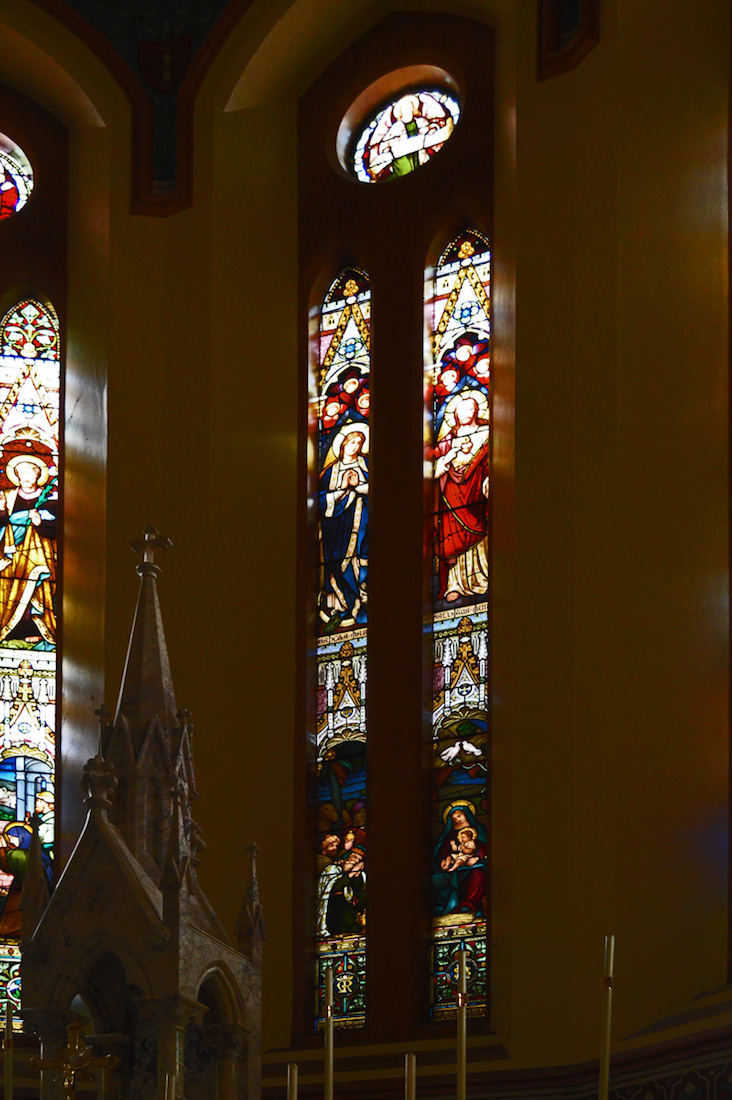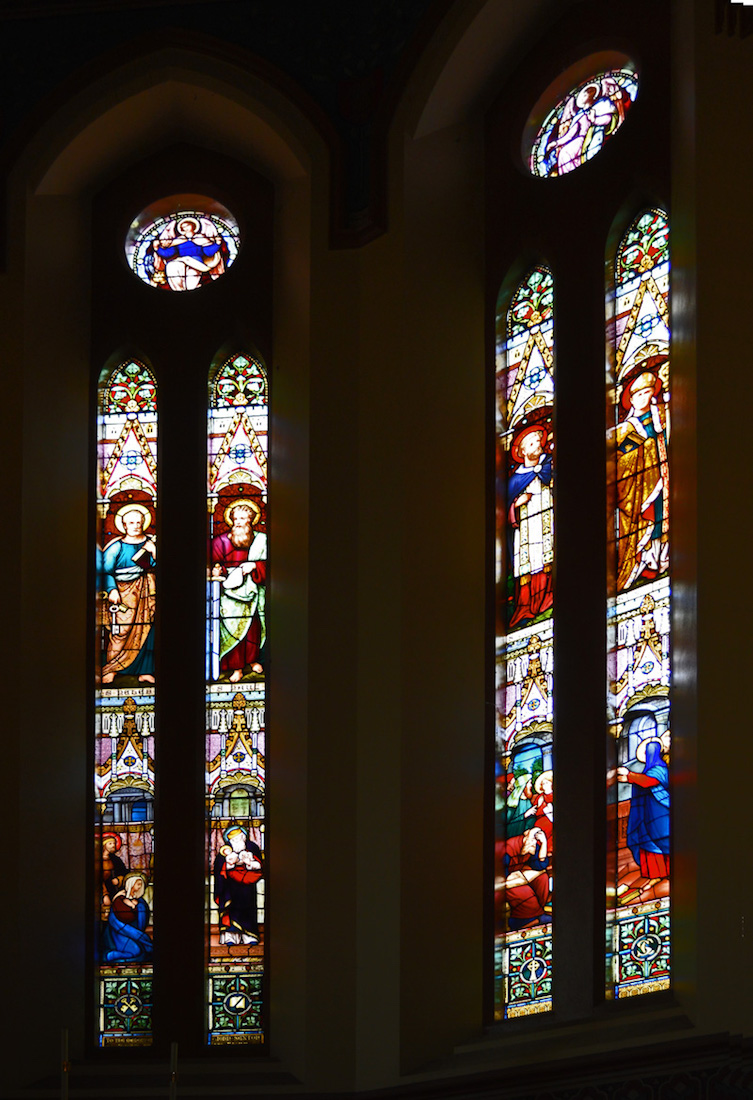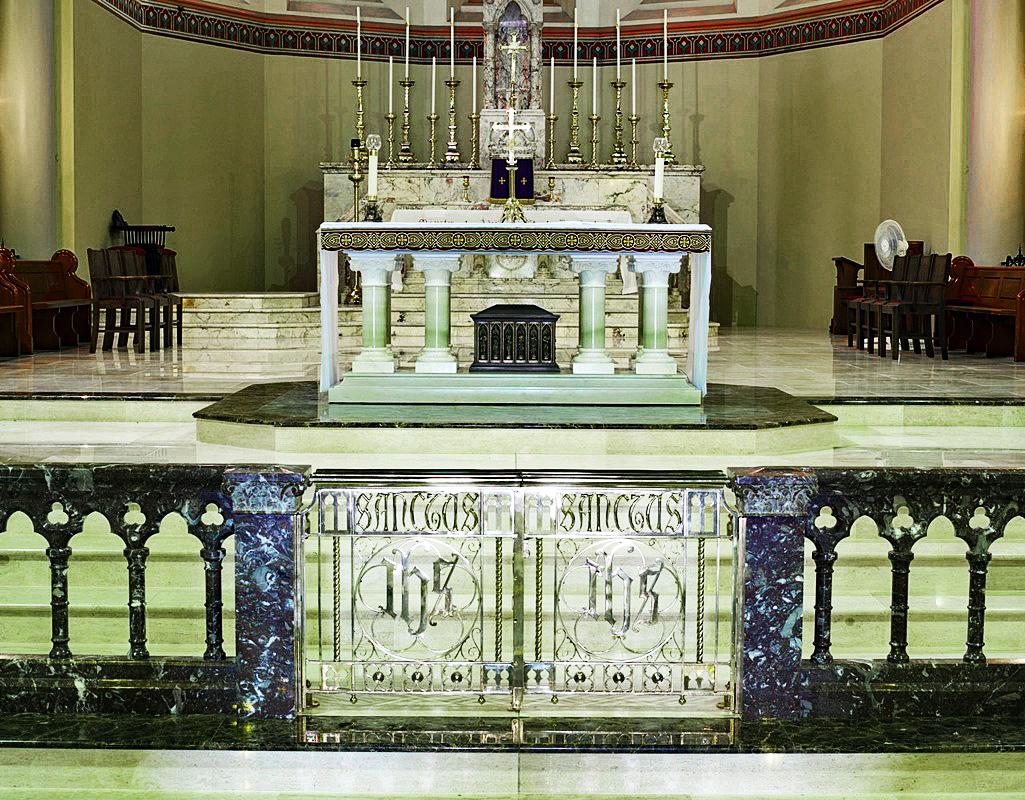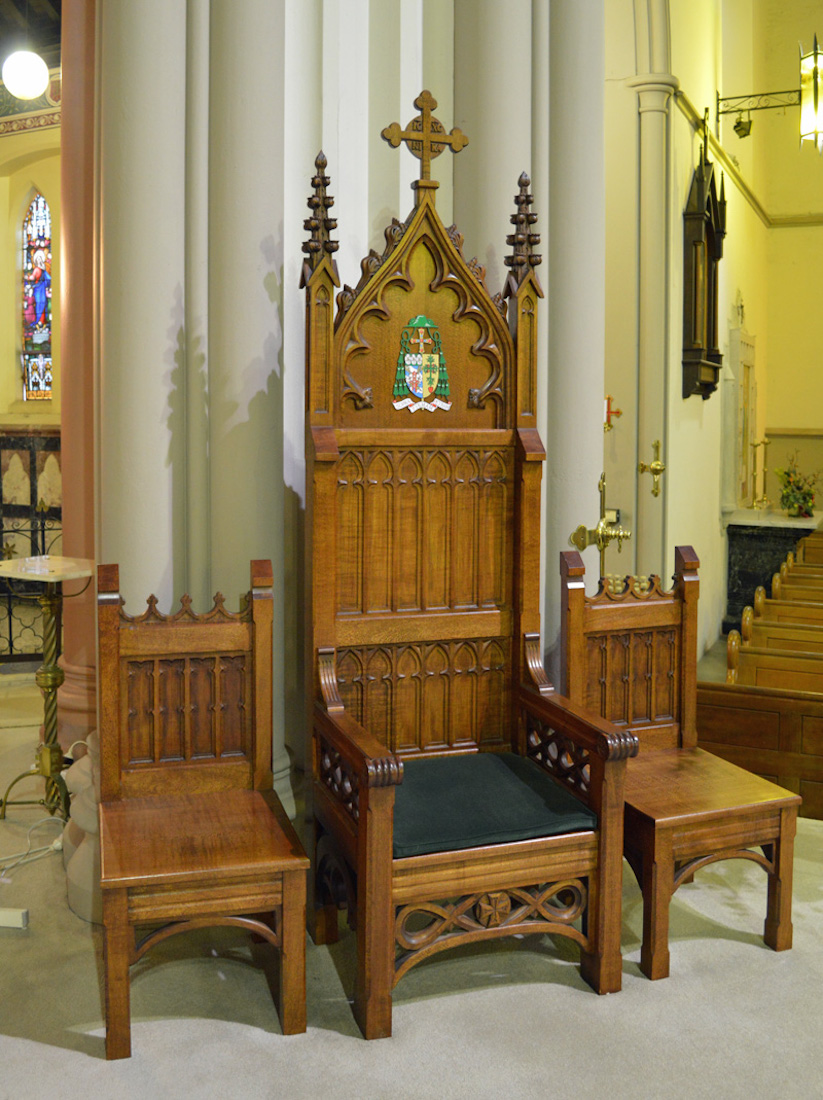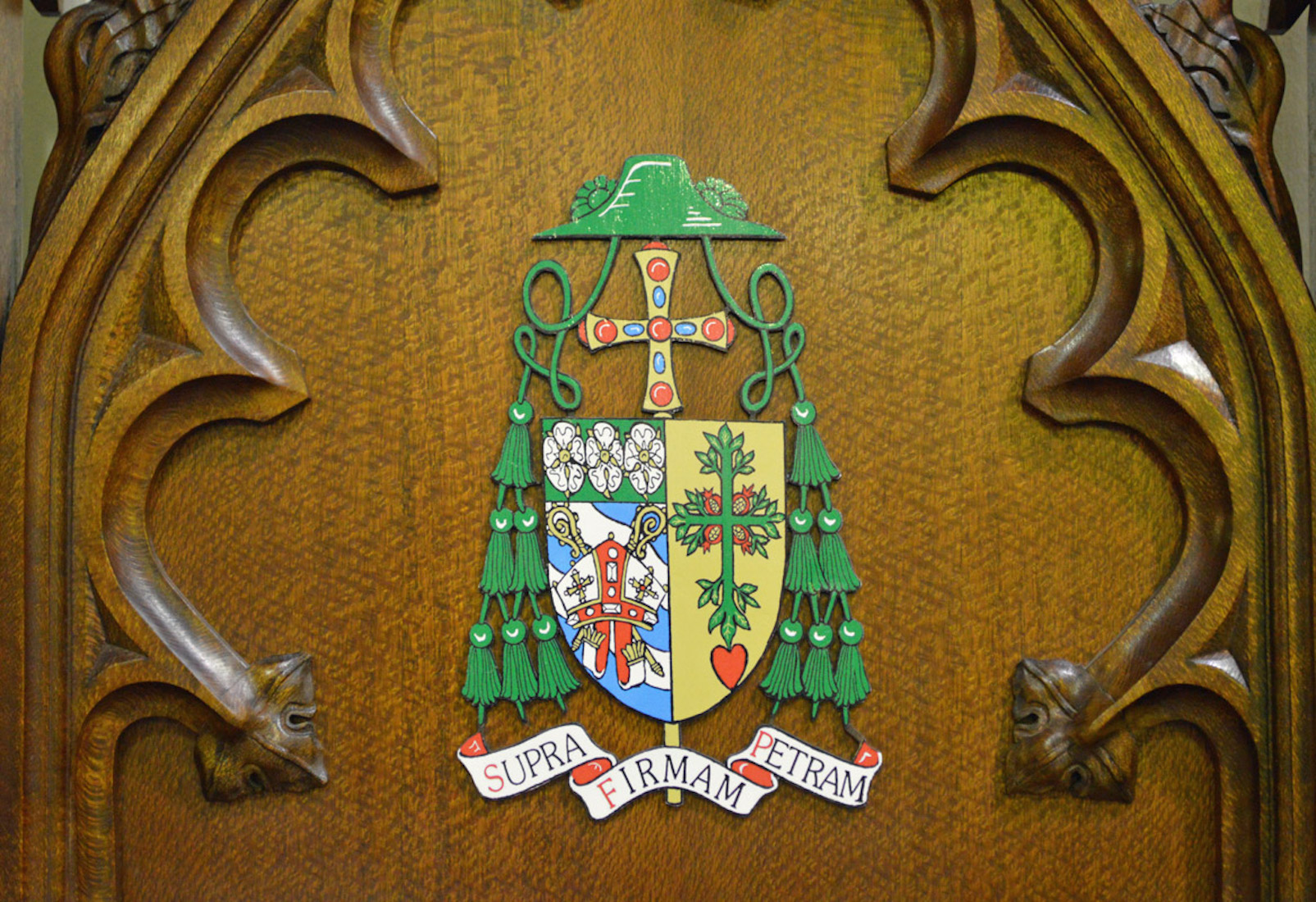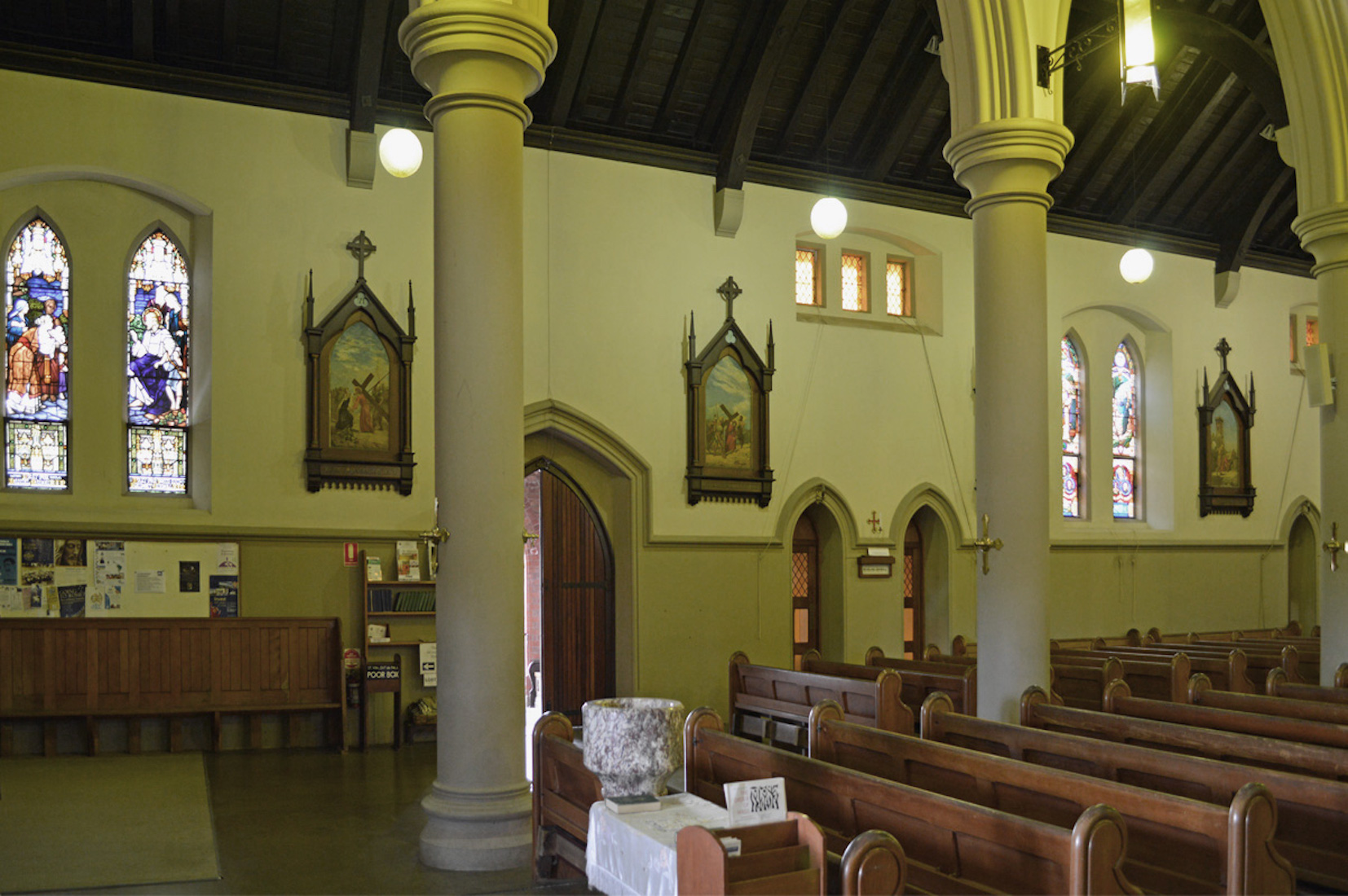
The North wall of the nave ... . We observe the two of the Stations of the Cross which line the walls of the nave and transepts, the open North door, the two Confessional doors with the small amber windows above, and at right, the second pair of stained glass windows. Notice too the brass fittings on either side of the supporting columns. PLAN
22. GAS LAMP HOLDER
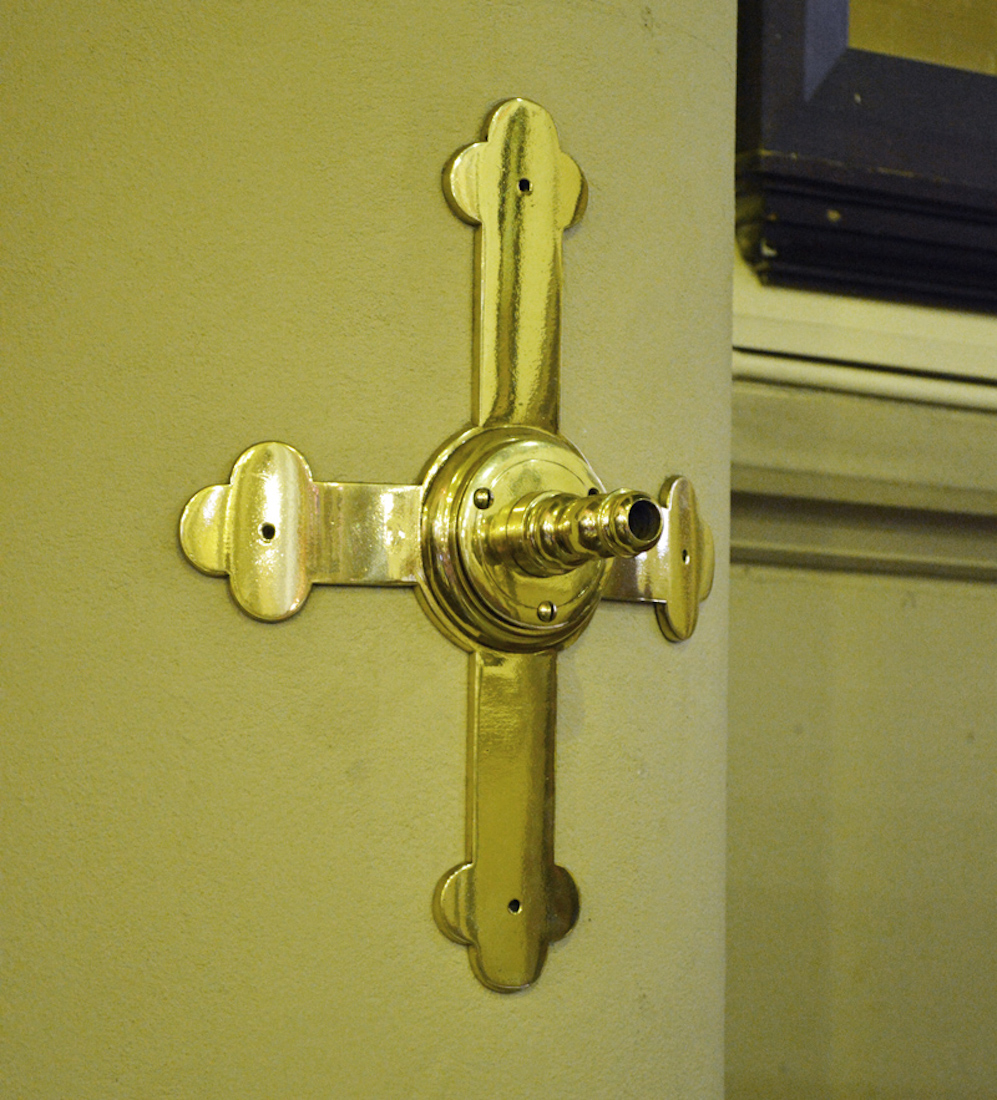
These old brass fittings on the columns are something of a mystery. Their present use is to secure the cords to the upper windows, but it is thought that they were originally supports for gas lamps used to light the Cathedral.
23. NORTH NAVE, EAST WINDOW
The left window features St John the Evangelist, Patron Saint of the Woodlawn College (near Lismore). John Carroll, Margaret Buckley and Fr Thomas Segrief, important figures in the College history are depicted below. Below these is an image of the College and a silo to remind us that Woodlawn was originally an Agricultural College built beside the Wilson River. ••• The right window features St Peter Chanel preaching the Gospel in Oceania to the people of Futuna, under the crest of the Society of Mary with its motto ”Sub Mariae Nomine”, (under the name of Mary). At the base of the window is depicted the Blessed Virgin, Queen of the Society of Mary, the famous shrine of Our Lady at Fouviere, Lyon, France where in 1816 twelve priests and seminarians pledged to found the Society of Mary, along with Father Jean Claude Colin, the founder of that Society.
24. NAVE COLUMN
A photograph of St Mary MacKillop hangs on the North column at the front of the nave, looking out over the congregation. Mary Helen MacKillop, also known as St Mary of the Cross, RSJ, was an Australian of Scottish descent who has been declared a saint by the Catholic Church. Notice the little gold harp on the hymn board.
25. NORTH TRANSEPT ORGAN
The grand romantic organ of St Carthage's was built by J. E. Dodd of Adelaide and installed in 1912 in the North Transept. In 1986, Brown and Arkley of Sydney began a program of rebuilding and restoring the organ. A blending of old and new pipework has given the instrument a quality of sound which is enhanced by the architecture of the Cathedral. The organ has been completely electrified and a new drawstop console built. The restoration was completed and the organ rededicated in March 1988.
26. FONT
The baptismal font stands near the North transept. It is fashioned from Caleula marble, and was installed in April 1917.
27. PULPIT DETAIL
The pulpit stands nearby, and we note the icon at the front. This depicts Christ in Glory – the Alpha and Omega, holding the world in his right hand. He is surrounded by a lion, an eagle, a bull (ox) and an angel, an image from the book of Revelation. The four creatures are often thought to represent the Four Evangelists: Matthew (angel), Mark (lion), Luke (ox), and John (eagle).
28. SACRED HEART CHAPEL
In the North East corner of the Cathedral is the Chapel of the Sacred Heart. We observe here in the foreground the solid marble railing and ornate tiling. Below the figure of the Sacred Heart is the gold tabernacle used to house the eucharist elements. We notice too the small figure at right.
29. CHAPEL WINDOWS
Behind the small reredos in the Sacred Heart Chapel are two windows. These recall a devotion propagated by St Margaret Mary Alacoque.
30. CHAPEL FLOOR
A feature of most Cathedrals is their floor tiling. This fine mosaic work is found in the Chapel of the Sacred Heart.
31. CHAPEL REREDOS
A close up of the figure of Christ in the Sacred Heart Chapel. Curiously, the ‘sacred heart’ is not in evidence.
32. TABERNACLE
Below the figure of Christ is the golden tabernacle. The central feature in the fine ornamentation is a heart and cross surrounded by a crown of thorns. Why the Fleur-de-Lis? It is a stylized representation of the lily. So in Catholic tradition with its association with the lily represents purity, and in turn to the Virgin Mary. As the Fleur-De-Lis comprises three petals and three sepals it also symbolises the Trinity. In Christian art the Fleur-De-Lis is also the attribute of the archangel Gabriel, notably in representations of the Annunciation.
33. LITTLE KING
When I see this figure, I think ‘The Little King’. The symbolism of the sculpture is obvious, but I have some personal misgivings about its appropriateness ...
34. SANCTUARY
Leaving the Chapel of the Sacred Heart (at left), we return to the centre of the Cathedral. Before us is ‘the chancel altar’ with the pulpit at left and the bishop’s cathedra at right. St Carthage is unusual in that this area is called ‘the forward sanctuary’, while behind is the Chapel of the Blessed Sacrament. [As before, this is a 2013 photo.]
35. CHAPEL OF BLESSED SACRAMENT WINDOWS
Here are the left two East windows. The subject of these five sanctuary windows is ‘The Five Joyful Mysteries of the Rosary’. These are devotions based on five events. Shown here at left is ‘The Annunciation’ in which the angel visits Mary and tells her of the coming birth of Jesus. At right is ‘The Visitation’ in which Elizabeth visits Mary.
36. EAST WINDOW
It is hard to get a good view of the central Eastern window because of the reredos behind the high altar, but the event here is The Nativity.
37. SOUTH EAST WINDOW
The Southern-most pair of the five sanctuary windows depict The Presentation of the baby Jesus to Simeon and Anna, and the Finding of the boy Jesus in the Temple.
38. CHANCEL ALTAR
The front wooden altar or ‘chancel altar’ was introduced to Cathedrals after the Vatican II Council. This altar is used for the celebration of the liturgy, and allows the priest to face the congregation. [Note: this is the new nave altr and sanctuary railing. This photo was supplied by Bishop Geoffrey Jarrett. He writes: ‘A new carrara marble high altar resting on eight pillars of green onyx from Pakistan was designed in the style and materials of the existing 1919 altar, forming an ensemble that avoids the impression of ’two altars, old and new.’]
39. CATHEDRA
The cathedra is the bishop’s throne, and it is the installation of the cathedra which entitles the church to be called a cathedral. A Catholic bishop is responsible for the churches in his diocese. The Lismore diocese is responsible for 105,000 Catholics in twenty eight parishes living along the picturesque coastline of New South Wales that extends from the Tweed River in the North to Camden Haven in the South.
40. COAT OF ARMS
The cathedra bears Bishop Geoffrey Jarret’s personal coat of arms. These are a decorated green cross on a gold ground. The arms of the cross end in leaves, as if the wood of the cross is living and growing. In the arms of the cross are four red pomegranates (fruit, opened to show seeds). At the foot of the cross is a red heart. The Bishop’s motto is SUPRA FIRMAM PETRAM (Upon a strong rock) with reference to (Mt 7:24), Christ’s charge to the apostle Peter (Mt 16:18); and Christ Himself who is the Rock (I Cor 3:11) and living stone on which the Church is built as a spiritual house in the lives of believers (I Peter 2:4-8).


